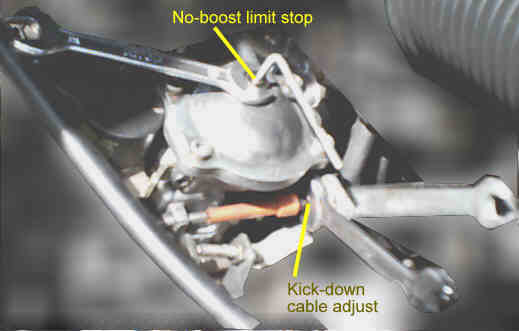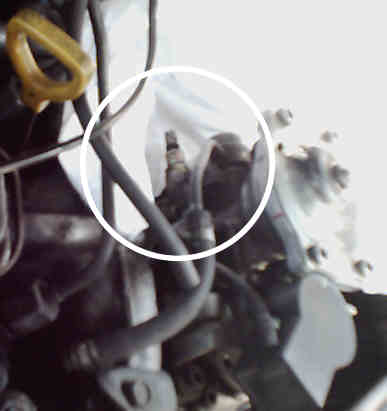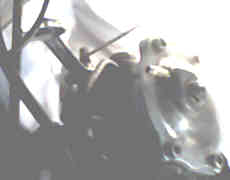(Home)
Fuel system
Pictures & diagrams ...
Accelerator. (Oblsud)
Emission Control Unit by sl/door (J Corfield #37)
Fuel filter. (Oblsud)
Fuel pipes. (Oblsud)
Fuel pump, turbo boost. (Oblsud)
Fuel tank & pipes. (Oblsud)
EGR, vacuum pipes. (Oblsud)
EGR, valve. (Oblsud)
EGR, view of arrangement (Ray Woolmer)
Exhaust. (Oblsud)
Glow Plug Relay (J Corfield #39)
Injectors. (Oblsud)
Tuning (2CT):
Remember, when making any adjustmemts experimentally, that the engine is notably sluggish before it has warmed up. Unless you are deliberately trying to overcome that problem only assess what you have done with the engine fully hot.
With aircon and "idle-up" off, idling should be at 800 rpm. Adjustment of the idling stop is straightforward. Note that it is bypassed by a compensator when the coolant is cold. Idling must be reset after some tuning adjustments.
The bowden cable from the fuel pump operating lever to the gearbox, usually referred to as the kick-down cable, controls when gear changes occur. The nuts locking the outer sheath to the side of the pump can easily be adjusted with two 14mm spanners (below). Adjust about "2 flats" then try it out. This adjustment too must be reset after some tuning adjustments.
There is a round diaphragm on top of the fuel pump which is pushed down by the turbo pressure. The plunger below it has an eccentrically-ground profile which is followed by a pin in the front (i.e. towards the front of the car) of the pump. The effect of turbo pressure is adjusted by rotating the diaphragm:
- remove the 4 Allen-head bolts and the cover but be sure not to turn the diaphragm accidentally.
- put a mark on the diaphragm (blob of paint?) and on the rim in which it fits so that you can track your adjustments. The you can pull out the diaphragm to see how it works and which way to turn it for more fuel - to make the ground section move nearer the rear of the car.
- adjust about 20 deg of rotation and see the effect when the turbo is boosting.
When there is no turbo pressure, which includes revving under no load in the MOT test, the diaphragm is in its highest position which is set by a limit stop right on the top which is easily adjusted with a 12mm spanner and an allen key (below). Adjust about 20 deg and test. Either just use trial and error or remove the cover (as above) to see how it works and which way to turn it for more fuel - to push the diaphragm down.

Maximum fuel screw. This is at the back of the fuel pump (i.e. towards the rear of the car). It's tricky to adjust but can be vital, e.g. to get emissions down in the MOT. The picture below is taken from over the engine, looking back towards the fuel pump and with the turbo pressure hose removed, for clarity, from the diaphragm assembly on top.

To adjust the maximum fuel screw loosen the 12mm locknut and turn the screw inside it. Screw it "in" to the pump for more fuel. It has a slot in the end but you need a very short screwdriver. It also has a hole through it and in the picture below you can see a piece of steel knitting needle stuck in that hole which allows precise adjustment to be made. Again adjust about 20 deg at a time, it is a very coarse adjustment.

Air filter
(NB UK liteace vans use a different air filter. EFI petrol versions have a square filter. )
For 2C-TD ...
Toyota 17801 54050 but a parts shop may recognise one of...
Fram CA4680
ADL ADT32210
Coopers AG 939
Fram CA 4744
Alco MD 304 or MD9826 (£9)
Champion W114
TJ filters B210
Direct DAF7 (£6)
Crossland 774
Try also Pipercross or K&N for a reuseable filter, the application is for Saab 90,99, and is a near perfect fit, just a few mm short.
There is a slightly different air filter for the 2.2 Diesels (3C-T?) - the Fram number is CA5273. It is the same shape/size as the standard Toyota part 17801-64080. The oil and fuel filters seem to be the same as for the 2C-T. Fuel Filter
Alco SP969 (£12), Fram P4922 or equivalent."FOREIGN AUTO PARTS" (0117 963 1649) in Bristol specialise in grey imports. All three filters, air, fuel and oil for K reg TD for around £27.00 - that's a VERY good price!
Turbo
The CT turbo in townies is water cooled. However Toyota advise keeping the engine running at idle for 20s to 2 minutes after heavy use such as high speed, uphill or towing, allowing the turbo to cool off rather than risk its bearings seizing.
Some vehicles have a turbo timer (switch on the stem) by which you can lock the car running without having to leave the key in the ignition, whereby it'll turn itself off after a while. Beneficial at motorway stops where the turbo has been working hard.
The turbo is not controlled by anything other than the flow of exhaust gases. It does not "cut in and out" but the air pressure it produces in the inlet manifold is monitored by the Turbo Indicator lights ... see Dashboard Fuel Tank
Townace TD holds 60 litres. When the light comes on, you've got 10 left,
Liteace has a fuel tank of about 42.5 litres capacity. The reserve is less than 5 litres. Fuel Filter
Draining ... The electrical lead is for a float switch, the water-in-fuel indicator. To drain the water, you loosen the nozzle at the base that the hose is connected to, then pump the primer until fuel, not water is expelled.
Changing ... The change procedure is simple-unplug the wiring connector, then unscrew the filter. Carefully unscrew the base bit, and attach it to the new filter (Fram P4922). Then you can just screw the filter in place and reconnect the wire. The engine will self-prime the new filter, but if you're feeling paranoid, you can either fill the new filter with clean diesel, or pump the priming bulb 20 imes or so. Fuel pump
Bosch are one of the few creators of diesel fuel pumps. I understand the Japanese either use them or copy them for use in Jap diesel motors. They also produce machines for testing the pumps and settings. This is quite a specialised job and to be done correctly, needs to have the pump removed from the car and setup on this machine. Hence the term "Bosch Fuel centre". A "Bosch fuel system center" said that they were now getting a lot of jap imports that were running a bit rich,the japs do this to get more torque out of the engine to compensate for the speed limiter, so that was probable the reson for poor economy. They retuned it for me and said that the emissions test should be between 1.3[lean] and 3.0[rich], mine was 12.6 - the richest that he had ever seen, I am now getting about 30mpg, much better. Set up cost me £56.00 but is saving me £10 /£15 a week.
"I would like to have it a slight amount back up, giving it a little bit more power again. Where can I adjust this myself without running back to them all the time? I think it is just a matter of trial and error until I get it just right?" - "If it's slow off the mark, and doesn't trail black smoke in the period between flooring the throttly and the turbo light coming on, you should make a fine adjustment to the off- boost fuelling stop. It's the allen screw and locknut arrangement on top of the diaphragm thing on top of the pump. You'll see how it works best if you remove the four screws and lift it off. Don't turn the diaphragm, though, that alters all the settings... You want to turn the stop so that the diaphragm assy is preloaded a bit more (to make it richer, for more power) - try less than an eighth of a turn, it doesn't take much."
Find a local diesel tuning specialist, not necessarily be a Bosch Centre, and get a quote for what they intend to do and make it clear that it is a Jap import but that it is a 2CT engine (as used in the Toyota Camry), before letting them loose on it.
Glow Plugs for the 2C-T engine.
NGK 703R (£22), Quinton Hazell QGP166 (£11), Balco 4444 (£8). EGR Valve, exhaust rebreathing system
The EGR sends a small amount of exhaust gas back into the intake for emissions purposes when the engine is under partial load, to improve the emissions. It does not operate at high load. It makes no visible difference to the smoke level, it affects only the composition of the gases. It can be disabled in the UK. There's a solenoid valve and a diaphragm assembly at the rear of the engine, beside the fuel filter. Just disconnect the flexible vacuum pipe from the top of the vacuum-operated valve to disable it. You must plug the end of the flexible pipe securely or other vacuum-operated systems, including the brakes, will be unreliable. If the EGR valve itself is faulty, it would be wise to make a small blanking plate (a piece of tin can with two holes will do) to seal off between it and the inlet manifold. It's only fitted to autos.
Fuel consumption
N. B. 10km per litre equals 28.25mpg (miles per Imperial gallon) - a good average, easy to check against."I get 35mpg (12.4km/l) out of my Mastersurf. Majority is motorway driving to & from work at 65-70mph + round town, etc at weekends."
"It varies between 24 and 27mpg. I own the Master ace Surf, 2 litre, Turbo Diesel, Automatic, 4WD."
"In a 1992 Lite Ace 2.0 TD on a 450 mile journey, loaded with 4 adults and 4 young'uns I averaged 36MPG."
"29mpg? not too bad!"
AA fuel prices
Fuel economy - ramblings
Kickdown and Overdrive, see Transmission
Tickover speed should be 750 - 850rpm, dropping to maybe 650 in gear.
The fast idle (idle-up) is controlled by two vacuum valves. One lifts the idle when the aircon is turned on, the other when the idle up switch is depressed (intended for use in cold weather, especially to make the heater more effective). However the idle up switch gets it's supply from the heater fan switch, so the fan has to be on for the idle-up to work. No relays in the circuit. The valves are on the top left hand side of the engine close to the air filter ... they are black and have a multipin connector for the wires. Exhaust system
A new rear exhaust section for a Townace from a Toyota dealer is approx £200 but at least they are made thicker by the manufacturer so it'll last 3-4 times longer than a non-Toyota one would - if they exist? Sections for a Liteace van don't fit.
Stainless Steel. Complete exhaust around £300. There are a number of distributors (link1 link2) for Powerflow exhausts, all stainless, inc welds and hangers, made to your spec, while you wait. You don't have to replace the whole system at once. Lifetime guarantee covers the installed components - the proviso is an annual free inspection(?) Intercooler
No Townace has an intercooler as standard. When the turbo compresses the intake air, it also heats it. This looses density, and you get less air for your money. A intercooler, if you can fit one, cools the air back down increasing it's density. This results in lower emissions, more power, and better mpgs. Typically 10% more power and the same improvement in economy result, along with better engine longevity. The downside is the £500 or so cost - (#846) David Miller, August 20, 2001 Spacecruiser timing
It doesn't look as though there is an adjustable vernier on the distributer for the Spacecruiser. You will need to loosen the bolt holding the distrubuter body and turn it slightly. Assuming the engine is NOT a 4Y-E, the timing should be 8 degrees BTDC @ 850 rpm max with vacuum advancer sub-diaphragm tube off and blocked. May be worth checking dwell also, should be 52 +/- 6 degrees @ idling.

